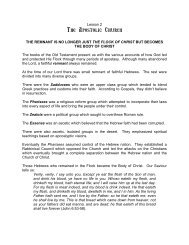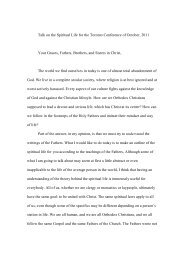According to the Scriptures - Saint Nektarios Greek Orthodox Church
According to the Scriptures - Saint Nektarios Greek Orthodox Church
According to the Scriptures - Saint Nektarios Greek Orthodox Church
Create successful ePaper yourself
Turn your PDF publications into a flip-book with our unique Google optimized e-Paper software.
<strong>the</strong> Old and New Testaments. Our Saviour is <strong>the</strong> vivifying Spirit without which <strong>the</strong> Old<br />
Testament is lifeless and unintelligible.<br />
In 2 Corinthians 3:14 - 16, St. Paul presents us with <strong>the</strong> fundamental principle of<br />
understanding <strong>the</strong> Old Testament:<br />
<strong>the</strong>ir minds were blinded; for until this day remaineth <strong>the</strong> same vail<br />
untaken away in <strong>the</strong> reading of <strong>the</strong> Old Testament; which vail is done<br />
away with in Christ.<br />
The Old Testament is a hidden mystery <strong>to</strong> those who are not in Christ; in <strong>the</strong> <strong>Church</strong>.<br />
This mystery became manifest only <strong>to</strong> those who have Christ in <strong>the</strong>m Colassians 1:26 -<br />
27. Our Lord revealed <strong>the</strong> mystery of <strong>the</strong> Old Testament <strong>to</strong> His Disciples (Luke 23:13 -<br />
35) but <strong>the</strong>y were not able <strong>to</strong> comprehend it until <strong>the</strong>y had received <strong>the</strong> fullness of <strong>the</strong><br />
Holy Spirit on Pentecost.<br />
If <strong>the</strong> Holy <strong>Scriptures</strong> are separated from our Saviour, <strong>the</strong>y become lifeless words.<br />
Outside <strong>the</strong> Body of Christ, Holy <strong>Scriptures</strong> lose <strong>the</strong>ir vivifying spirit. The Holy Fa<strong>the</strong>rs<br />
teach us that <strong>the</strong> Holy <strong>Scriptures</strong> belong exclusively <strong>to</strong> <strong>the</strong> <strong>Church</strong> and form an integral<br />
part of what St. Irenaeus labeled The Canon/Rule of Truth (Against Heresies, I,10, 1;<br />
Proof, 6). St. Clement of Rome, a disciple of <strong>the</strong> Apostles, uses <strong>the</strong> term Canon/Rule<br />
of Tradition (1 Clement, 7, 2; 31, 1; 36, 1). Later it is referred <strong>to</strong> as The Canon/Rule<br />
of Faith. This Canon or Rule, which has <strong>the</strong> Apos<strong>to</strong>lic writings as its foundation and<br />
support (Proof 1, 1), is contained within <strong>the</strong> life of <strong>the</strong> <strong>Church</strong> as a precious deposit in<br />
an excellent vessel (A. H. III, 24:1).<br />
The <strong>Church</strong> holds within her bosom <strong>the</strong> revelation of God as a Holy deposit. <strong>According</strong><br />
<strong>to</strong> St. Meli<strong>to</strong>, <strong>the</strong> <strong>Church</strong> is <strong>the</strong> deposi<strong>to</strong>ry of <strong>the</strong> Truth (Pascha 40) This revelation is not<br />
dormant but alive and life-giving just as <strong>the</strong> breath of God is for man, vivifying every part<br />
of <strong>the</strong> body (A. H. 24, 1). This Deposit of <strong>the</strong> Truth which brings life <strong>to</strong> every member<br />
of <strong>the</strong> Body of Christ is not confined <strong>to</strong> <strong>the</strong> written word. Knowledge of God is conveyed<br />
by The Spirit of Truth <strong>to</strong> all <strong>the</strong> members of <strong>the</strong> Body of Christ. St. Irenaeus states that<br />
even though <strong>the</strong> Christians of Gaul could not read <strong>the</strong> <strong>Scriptures</strong> since <strong>the</strong>y did not<br />
know <strong>Greek</strong>, <strong>the</strong>y never<strong>the</strong>less had salvation written in <strong>the</strong>ir hearts by <strong>the</strong> Spirit, without<br />
paper or ink (A.H. III, 4, 2).<br />
Every book of <strong>the</strong> New Testament includes somewhere on its pages a citation or an<br />
allusion <strong>to</strong> <strong>the</strong> Old Testament. These allusions are as much an opening up of <strong>the</strong><br />
<strong>Scriptures</strong> (Luke 24:32) as <strong>the</strong> quoting of <strong>the</strong> very words of <strong>the</strong> Holy Prophets. It is <strong>the</strong><br />
Mystery of our Lord’s Incarnation which is <strong>the</strong> key <strong>to</strong> <strong>the</strong> opening up <strong>the</strong> whole of <strong>the</strong><br />
Old Testament, not just <strong>the</strong> words of <strong>the</strong> Prophets.<br />
In order <strong>to</strong> fully understand what is taught in <strong>the</strong> New Testament, we must first come <strong>to</strong><br />
an understanding of how <strong>the</strong> New Testament is <strong>to</strong> be read through <strong>the</strong> eyes of <strong>the</strong> Old<br />
or as we confess <strong>According</strong> <strong>to</strong> <strong>the</strong> <strong>Scriptures</strong>.<br />
As part of The Canon of Truth, <strong>the</strong> Old Testament writings find <strong>the</strong>ir fullness within <strong>the</strong><br />
Apos<strong>to</strong>lic writings of <strong>the</strong> New Testament. St. Irenaeus and <strong>the</strong> Apos<strong>to</strong>lic tradition which<br />
9





